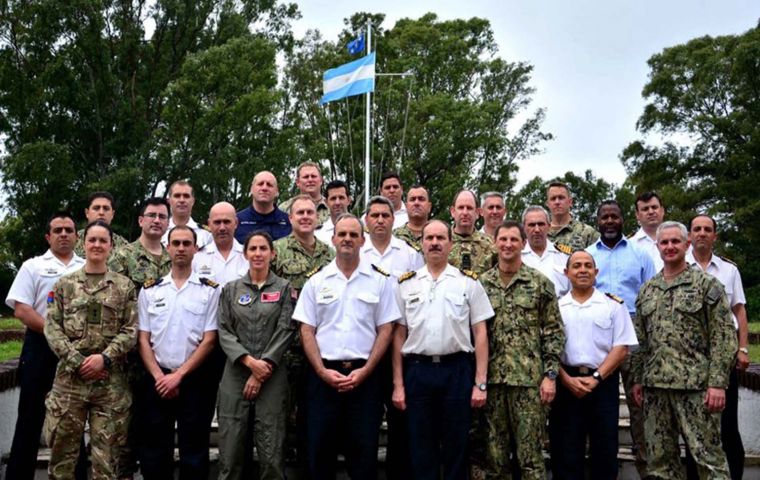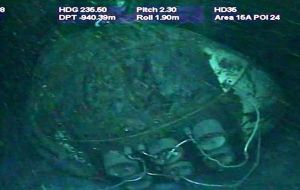MercoPress. South Atlantic News Agency
Royal Navy submariners honored for mission to help locate missing Argentine sub ARA San Juan
 The international search team in Argentina
The international search team in Argentina  San Juan torpedo tubes and pressure hull
San Juan torpedo tubes and pressure hull  Vice Admiral Kyd presents his commendation to the rescue team in Gosport
Vice Admiral Kyd presents his commendation to the rescue team in Gosport British submariners have been recognized for their efforts to help Argentina find missing sub San Juan. An eight-strong military team and one civilian were flown to the South Atlantic as part of the massive search effort sparked when the submarine vanished in November 2017. They have earned a commendation from the UK’s second most senior sailor, Fleet Commander Vice Admiral Jerry Kyd.
Their efforts not only helped to narrow down the search – and assist with the eventual location of the submarine, providing closure for the distraught families – but also built huge bridges with the Argentine people and Navy.
Britain maintains a rescue team on round-the-clock standby to respond to any submarine accident or disaster around the globe – such as the loss of the Kursk back in 2000 or the successful rescue of the Russian midget-submarine AS-28 when it became trapped in the Far East in 2005.
The Submarine Escape Rescue Advisory Team, based in Gosport but due to move to Faslane as part of the concentration of all British submarines and supporting services/facilities on the Clyde, were alerted after the ARA San Juan disappeared about 400 miles north of the Falkland Islands on passage from Ushuaia at the tip of South America to Mar del Plata, south of Buenos Aires.
The British advisors were split between the Falkland Islands, Antarctic patrol ship HMS Protector and embedded within the search effort in Argentina – which is equipped with a state-of-the-art sea-bed-scanning multi-beam sonar – and Comodoro Rivadavia, from where the search was being directed.
Using their vast knowledge of underwater operations, weather conditions – the search was being badly hampered by very rough seas when the Brits arrived – and how long the crew might survive to narrow down and guide the search effort.
The disappearance of the submarine prompted a massive international rescue effort involving more than two dozen ships, 11 aircraft and 4,000 military personnel who searched 1,044 square miles of ocean – about twice the size of Leeds – dropping 640 sonobuoy listening devices into the Atlantic during the fortnight-long search.
Warrant Officer Stephen Thorpe, who was flown to Puerto Belgrano Naval base near Bahia Blanca to join the search and control effort, said: “Despite the sad outcome and the loss of 44 submariners, the Argentine military and people were welcoming and appreciative of the assistance offered – it was an unforgettable experience.”
It all proved to be in vain. Acoustic data picked up by scientists who normally monitored possible nuclear detonations suggested a tremendous explosion had occurred a couple of hours after the San Juan’s final transmission – and before the rescue mission got under way.
The boat was eventually discovered by deep-sea exploration firm Ocean Infinity, resting in a canyon nearly one kilometer down. The San Juan had imploded when she exceeded her pressure depth about 400 meters beneath the surface, killing all 44 souls on board immediately.
Despite the tragic ending to the rescue mission, the British team’s input proved of great assistance to the hosts.
The head of the Argentine Submarine Service, Francisco Oleiro, said that “since the start of the search, we never felt alone.
He continued: “From the depths of our hearts and from the families of the crew of the San Juan, we want to thank all the support and solidarity we received in these hard days from all the nations that are part of this community.
“On behalf of the Argentine submarine branch, thank you very much and God bless you.”
Admiral Kyd said the Royal Navy team’s involvement in the search had proved essential in eventually locating the lost submarine and provided “closure to the Argentine government and the families of those tragically lost.”
The British mission also provided some useful firsts: the first British military aircraft to land in Argentina since before the 1982 Falklands conflict at Bahia Blanca airport and the longest flight by an RAF Voyager transporter, which flew special rescue ‘pods’ out to Comodoro Rivadavia to assist with the effort.
It covered 7,795 miles from RAF Brize Norton without refueling during a 16-hour flight. (Royal Navy).




Top Comments
Disclaimer & comment rules-

-

Read all commentsEngland will return the Malvinas within 25 years.
Aug 01st, 2019 - 02:55 am 0England will return the Malvinas within 25 years.
Aug 07th, 2019 - 02:38 am 0Commenting for this story is now closed.
If you have a Facebook account, become a fan and comment on our Facebook Page!